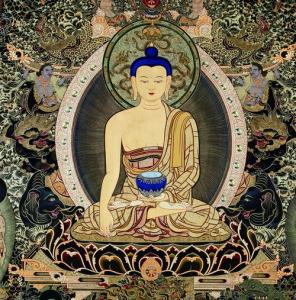 You can’t do what alone?
You can’t do what alone?
Traditionally in the buddhadharma across schools, samādhi (calming, concentration or absorption) and vipaśyanā (insight, or in Zen, “kenshō,” seeing true nature) are regarded as the two wings of meditation. And although there seems to be wide agreement in the general tradition that both are necessary for waking up and living accordingly, there is a wide range of views on the emphasis of the two wings, including within the Zen tradition.
At it’s best, the present just-sitting tradition, for example, emphasizes samadhi (e.g., Bokusan’s “Deeply settled heart of the Sōtō school”), while the kōan-introspection tradition emphasizes kenshō (e.g., “mu,” “who?” and “sound of one hand”). It is generally agreed, however, that some degree of samādhi is necessary for awakening, but, as I said, you will find a great deal of variance between and within schools, as well as within and between sub-lineages.
Personally, samādhi was vital for my process and continues to be, as Dōgen said, “the dharma gate of peace and happiness.” But it is seeing through kōan that really enlivens and provides clear instruction for how to integrate samādhi and kenshō within the vertiginous vicissitudes of daily life.
One genius aspect of the mu kōan is how it serves as both a samādhi practice (“be mu“) and an insight practice (“what is mu?”). Subsequent kōan serve to clarify awakening, while also encouraging cultivating verification. Authentic samādhi, by the way, generally requires extensive retreats, while kōan were developed in order to support people doing the work of awakening during chaotic times and in the midst of householder lives.
Through my Zen teaching practice, I’ve seen quite a wide range of capacity for samādhi. That is, some students find settling the mind easy and some find it difficult. And even after the mind settles, there are numerous challenges that arise before a student settles into samādhi and doesn’t mistake subtle laxity, for example, for one-pointedness.
Because some degree of samādhi is usually necessary for awakening, it is important to work with a skilled teacher to cultivate a settled mind to the degree possible for you and within your life circumstances. During this “setting the heart” stage of practice, it is necessary to focus and restrain from chasing after shiny objects, even/especially shiny dharma objects.
Although there are many positives to our present “dharma scene,” including access to a multitude of teachings and teachers via the internet and also “coming soon to a dharma center near you,” given that none of us have much time in this life, it may be best to practice some serious restraint. The many teachings and teachers quickly become noise in the system.
Take kōan for instance. You’ll hear many things about them, pro and con, often from people who haven’t seen through a single kōan, so most of what you’ll read is much like gossip. Of course, some amount of information about the pros and cons can be helpful, and it is wise to know something about what you’re getting yourself into. And then, if you are determined to see it through and through (mu or who? or whatever you’re assigned), then wide reading and learning can just result in dissipation and confusion. So I recommend finding a skilled teacher with whom you feel some affinity, and then taking up the practice you’re offered, throwing yourself into with wholeheartedness, uncommon focus and integrity, and minimal looking around.
Perhaps the essential quality of taking the student seat is to acknowledge that we don’t know what we’re doing, and we aren’t sure where we are on the path. We then inquire of our teacher (e.g., the practitioner on the teacher’s seat) to learn about samādhi and subtle realization. We place ourself in the care, under the guidance, of someone who has direct experience through their own process, not just from browsing on the internet. We allow our teacher to see where we’re at on this journey, and make adjustments to our practice as prescribed. This relational aspect of practice is an essential skill very different from the self-diagnosis of both samādhi and kenshō that seem to be raging on the internet now, especially in Facebook forums.
The possibilities of samadhi and kenshō do not function apart from the teacher-student and community relationships. These are essential for the full functioning of awakening, carrying all beings across.
May we all fully awaken and function freely.











